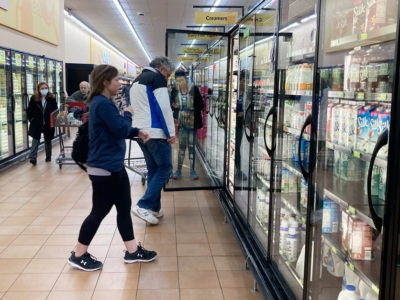| Title XI: Crop Insurance | |||
https://www.fca.gov/bank-oversight/about-banks-and-associations
Title IV: Nutrition
What it does: Reauthorizes the Supplemental Nutrition Assistance Program and other nutrition assistance programs. SNAP has long accounted for the lion’s share of spending under the farm bill, and its price tag has nearly doubled from the enactment of the 2018 farm bill, when its 10-year cost was estimated at $664 billion, to the latest 10-year forecast of $1.2 trillion.
The title also reauthorizes food distributions, including The Emergency Food Assistance Program (TEFAP), which provides products to food banks, and several small nutrition assistance programs. Those include the Farmers’ Market Nutrition Program and the Gus Schumacher Nutrition Incentive Program (GusNIP).
School meal programs are largely funded through other legislation, but USDA’s fresh fruit and vegetable program for schools is funded through this section of the farm bill.
What it costs: Nearly 84% of the projected 10-year cost of farm bill programs through 2033.
What’s in play: Congress already had an ugly battle over work requirements during the debt ceiling bill negotiations, which resulted in expanding the requirements from 49-year-olds to 54-year-olds but also added new exemptions for veterans, homeless individuals and foster children graduating out of the system. Amendments may still come up during the farm bill related to work requirements, but Republicans may also push for tightening rules for states to get waivers from the work rules.
 (AP Photo/Nam Y. Huh) | (AP Photo/Nam Y. Huh)
(AP Photo/Nam Y. Huh) | (AP Photo/Nam Y. Huh)Another hot issue heading into the farm bill debate is USDA’s update of the Thrifty Food Plan, which is used to calculate SNAP benefits, following language in the last farm bill. Senate Republicans have been particularly upset with the process USDA used to make those changes, as many assumed the changes would be budget-neutral. While a few House conservatives would like to claw back the $256 billion estimated cost increase of the TFP change, House Republicans are likely to focus more on imposing guardrails around future TFP updates.
Some lawmakers want to allow SNAP benefits to be used for hot foods such as rotisserie chickens. But those products can be costly, and it could be tricky to avoid picking winners or losers in the deli case, a House Republican aide says. Still, the bill might allow the idea to be tested. USDA has allowed SNAP purchases of hot foods after natural disasters.
GusNIP has gotten increased attention from advocates of “food is medicine,” the idea that good nutrition can improve health outcomes, but Senate Ag Committee Chairwoman Debbie Stabenow, D-Mich., is playing down the prospects for a funding increase.
Notable marker bills:
S.1488 — The EATS Act of 2023, not to be confused with a bill by the same name introduced by Sen. Roger Marshall, R-Kan., is the Enhance Access to SNAP Act of 2023, introduced by Sen. Kirsten Gillibrand, D-N.Y. It would permanently allow college students enrolled half-time or more to get SNAP benefits.
S.1485 — The Healthy SNAP Act of 2023, proposed by Sen. Marco Rubio, R-Fla., would bar purchases of junk food with SNAP benefits.
H.R.1550 and S.1062 — The Jobs and Opportunities for SNAP Act of 2023, led by Rep. Jake LaTurner, R-Kan., and Sen. John Kennedy, R-La., would expand work requirements to adults up to age 65 and parents with dependents under 7 years of age.
H.R.3474 and S.1036 — Proposals led by Rep. Suzanne Bonamici, D-Ore., and Sen. Bob Casey, D-Pa., to increase the minimum monthly SNAP benefit for all participants and simplify the application and certification process for nutrition programs.
S.497 and H.R.1763 — Military Family Nutrition Access Act of 2023, led by Sen. Tammy Duckworth, D-Ill., and Jimmy Panetta, D-Calif., would exclude military housing allowances from income when determining eligibility for SNAP.
S.949 and H.R.253 — The Puerto Rico Nutrition Assistance Act, introduced by Gillibrand and Jennifer González-Colón, Puerto Rico’s resident commissioner in Congress, would make the territory eligible as a state in SNAP. Food assistance in Puerto Rico and other territories is funded through block grants.
S.2210 — The Rubio-proposed SNAP Education Allocation Modernization Act of 2023 would increase funding for nutrition education and obesity prevention.
S.1474 — The Dairy Nutrition Incentive Program Act of 2023, led by Sen. Amy Klobuchar, D-Minn., to incentivize SNAP purchases of milk, cheese and yogurt by expanding the Health Fluid Milk Incentives Program.
H.R.3037 and S.1336 — The Closing the Meal Gap Act of 2023, led by Rep. Alma Adams, D-N.C., and Gillibrand, to change how SNAP benefits are calculated from the Thrifty Food Plan to the Low-Cost Food Plan.
H.R.4149 and S.2015 — Proposal by Rep. Lisa Blunt Rochester, D-Del., and Sen. Cory Booker, D-N.J., to increase funding for GusNIP.






